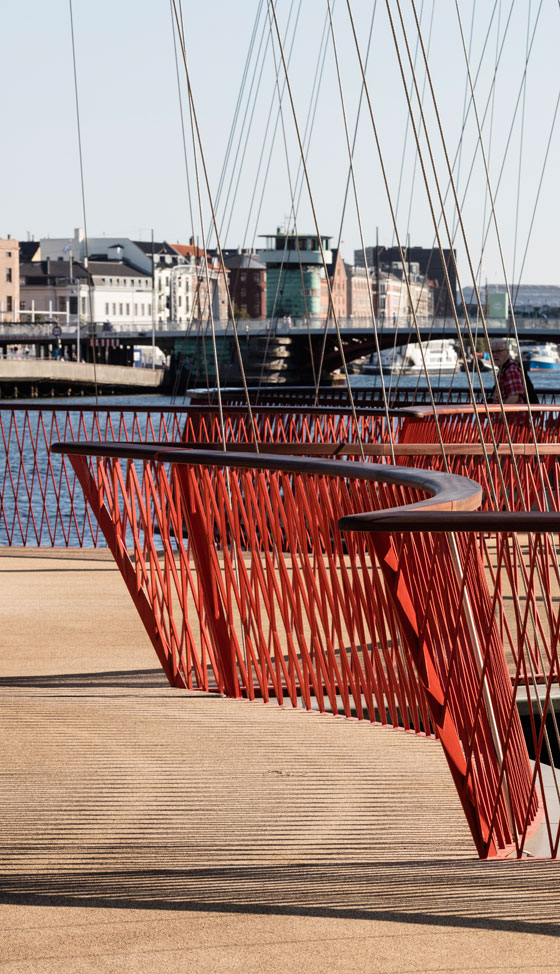Get over yourself
Texto por Alyn Griffiths
London, Reino Unido
22.02.16
Recent landmark bridge architecture shows how this most utilitarian of construction types, when imaginatively planned, can add real regenerative value to its environs. Build a bridge and get over it, people!
MXT Studio’s bright-orange steel bridge hovers above a motorway in Lisbon, providing a highly visible landmark within the neighbourhood. It features a tapered profile that accentuates the points where its multiple paths converge

MXT Studio’s bright-orange steel bridge hovers above a motorway in Lisbon, providing a highly visible landmark within the neighbourhood. It features a tapered profile that accentuates the points where its multiple paths converge
×The best bridges resolve issues of accessibility in efficient and often imaginative ways. They create physical connections that promote improvements to the infrastructure on either side, often helping to enliven previously under-performing areas. A survey of some recent examples reveals the regenerative effect intelligently designed bridges can have on a town or city’s public realm.
The basic function of a bridge is to provide a crossing between two points: beyond this, its form is open
to creative interpretation. When designing the Cirkelbroen bridge over Copenhagen’s Christianshavns Kanal, artist Olafur Eliasson drew inspiration from the area’s sailing heritage. The bridge comprises a series of five intersecting circular platforms, each with their own masts, to which steel cables resembling a ship’s rigging are attached. Rather than being arranged in a straight line, the platforms are offset to encourage a more circuitous route that allows users to slow down and enjoy different views of the city.
The Cirkelbroen bridge in Copenhagen was designed by artist Olafur Eliasson to carry pedestrians and cyclists across one of the city’s many canals. Rings housing LED lighting hang above its five intersecting circular platforms; photos Anders Sund Berg

The Cirkelbroen bridge in Copenhagen was designed by artist Olafur Eliasson to carry pedestrians and cyclists across one of the city’s many canals. Rings housing LED lighting hang above its five intersecting circular platforms; photos Anders Sund Berg
×In Rotterdam, a project overseen by interdisciplinary studio ZUS demonstrates how bridges can help revitalise neglected neighbourhoods by creating new pedestrianised thoroughfares. The project team developed the Luchtsingel bridge to reconnect three districts near the city’s main railway station. The 400-metre structure extends from the station quarter to a park and passes through a renovated office building now housing an incubator for young entrepreneurs. Initial funding for the project was raised by inviting the public to purchase a board inscribed with their name for €25. More than 8,000 boards were sold.
The Luchtsingel bridge was developed by Rotterdam studio ZUS to revitalise areas in the centre and north of the city by creating a pedestrianised access route that connects various public realm projects, including a park and a harvestable rooftop garden

The Luchtsingel bridge was developed by Rotterdam studio ZUS to revitalise areas in the centre and north of the city by creating a pedestrianised access route that connects various public realm projects, including a park and a harvestable rooftop garden
×In the Portuguese capital, Lisbon, Maximina Almeida and Telmo Cruz of MXT Studio responded to a competition brief calling for the promotion of more ecological transportation by proposing a bridge across a major highway. Intended for travelling “on foot, bicycle, skateboard, skates, Segway or any other [alternative to driving],” access to the bridge is provided by stairs and ramps that converge above the road. Supporting pillars are positioned to either side of the highway, allowing the central section to seemingly hover over the traffic. The bridge branches off in several directions on either side, connecting with existing pedestrianised routes.
Elongated ramps with gentle inclines ensure this bridge in Lisbon is suitable for cyclists, who can use it to traverse the busy highway and continue their journeys using existing paths and infrastructure on either side

Elongated ramps with gentle inclines ensure this bridge in Lisbon is suitable for cyclists, who can use it to traverse the busy highway and continue their journeys using existing paths and infrastructure on either side
×Within a city’s infrastructure, a bridge’s role is to connect areas where access was previously limited. In some scenarios, the main issue is traversing a vertical rather than a horizontal obstacle. For many years, elderly residents of Hernani in northern Spain struggled to find a suitable route between the historic centre at the top of a steep hill and a newly developed neighbourhood with a medical centre and sports complex at the bottom. The solution developed by local architecture studio Vaumm is an elevated walkway leading to a lift that descends to the plaza below. The bridge extends above the grassy slope to rest on an old stone retaining wall, where it widens to invite passers-by to enter.
A lift connected to a bridge makes it easier for elderly residents to move between two neighbourhoods in the Spanish town of Hernani. A secondary bridge halfway up also provides access to the adjacent sports centre

A lift connected to a bridge makes it easier for elderly residents to move between two neighbourhoods in the Spanish town of Hernani. A secondary bridge halfway up also provides access to the adjacent sports centre
×These bridges demonstrate how new crossings can invigorate a community, by improving access to previously hard-to-reach areas and providing a focal point around which supporting infrastructure can be developed. The architect’s role in this scenario is to ensure that bridges fulfil their practical requirements whilst enhancing the experience of getting from one place to another. Sometimes the journey is just as important as the destination.






















